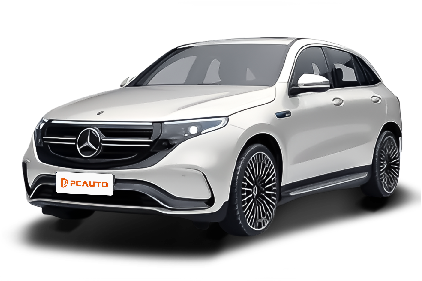Q
Does the Mercedes EQC have spare tyres?
As a pure-electric SUV, the Mercedes-Benz EQC doesn't come standard with a traditional spare tire in the Malaysian market. Instead, it's equipped with a Tire Repair Kit, which is a common configuration for many electric vehicles. This is mainly to reduce weight and save space, as electric vehicles are more sensitive to range and space utilization. The repair kit includes tire sealant and an air pump, which can handle minor tire punctures. However, in case of a blowout or severe damage, you still need to contact roadside assistance or go to a service center.
For Malaysian users, the tropical climate and complex road conditions may increase the risk of tire wear. It's recommended that car owners regularly check the tire condition (including tire pressure and wear) and know the location of the nearest authorized Mercedes-Benz service center for emergencies. If you're planning a long-distance trip or have a strong need for a spare tire, you can consult the dealer to see if there's an original-factory spare tire option. Some models may support the installation of a space-saver spare tire (at the cost of some trunk space).
Other luxury electric vehicles like the Audi e-tron or Jaguar I-PACE also adopt a similar design. Car owners can improve driving safety by planning their routes in advance and getting familiar with the use of emergency tools.
Special Disclaimer: This content is published by users and does not represent the views or position of PCauto.
Related Q&A
Q
Does EQC have parking assist?
Yes, the Mercedes-Benz EQC is indeed equipped with an advanced Parking Assist system. This feature helps drivers park more easily in the narrow parking spaces commonly found in Malaysia or in the congested urban environments. The EQC's Parking Assist system typically includes functions such as automatic parking into a space, parallel parking assistance, and a 360-degree camera. It uses ultrasonic sensors and cameras to monitor the surrounding environment in real-time. Some models even support remote parking, allowing drivers to control the vehicle into a parking space from outside the car via a mobile app.
This technology is especially useful for Malaysian drivers, particularly in busy cities like Kuala Lumpur, as it can significantly reduce the stress and risk of scratches when parking. Moreover, modern parking assist technology is not exclusive to Mercedes-Benz. Many other brands, such as BMW, Audi, and locally popular ones like Toyota and Honda, also offer similar systems, though the specific functions may vary depending on the model and configuration.
If you're interested in the EQC's parking assist features, it is recommended that you take a test drive at a nearby authorized Mercedes-Benz dealership to experience its convenience firsthand. At the same time, you can also compare the technical features of different brands to choose the model that best suits your needs.
Q
Does EQC have coolant?
Yes, as a pure-electric SUV, the Mercedes-Benz EQC doesn't have a traditional internal combustion engine, but it is still equipped with a cooling system, which includes coolant. The coolant is mainly used for temperature management of the battery pack, electric motor, and power electronics to ensure that these critical components operate within the optimal temperature range, thereby improving efficiency and extending their service life. In Malaysia's hot climate, the role of the cooling system is particularly important, as high temperatures may affect battery performance and the overall reliability of the vehicle. Although electric vehicles don't require frequent coolant replacement like fuel-powered vehicles, it is still necessary to regularly check the coolant level and condition. For the specific maintenance schedule, you can refer to the official Mercedes-Benz manual. In addition, the cooling system of an electric vehicle is usually more complex than that of a fuel-powered vehicle because it needs to manage the temperatures of multiple components simultaneously. This is also why the cooling system of the EQC is designed to be more precise. If you have more questions about the EQC's cooling system or other electric vehicle technologies, it is recommended to consult a Mercedes-Benz authorized service center, and they can provide more professional answers and maintenance advice.
Q
Does EQC euip with massage seats?
As a luxury electric SUV, the Mercedes-Benz EQC offers high-standard comfort configurations in the Malaysian market. However, the seat functions that come as standard from the factory may vary depending on the model version. Take the latest EQC as an example. Some high-end models do offer the option to install multi-way power-adjustable seats with a massage function. This configuration is usually integrated into the "Energizing Comfort" package, which includes a hot-stone massage mode and multiple intensity adjustments. However, the specific configuration should be based on the vehicle list provided by local Malaysian dealers.
Regarding the comfort configurations of luxury electric vehicles, currently, most brands offer the seat massage function through optional packages. For example, the comfort seat optional package of the BMW iX3 or the luxury seat kit of the Audi e-tron. This type of function mainly uses an airbag array to provide lumbar/shoulder pressure. However, there are differences in the massage program logic (such as wave-type or acupressure-type) and the body areas covered among different brands.
It is recommended that Malaysian consumers ask the dealer to demonstrate the actual massage effect when making a purchase. At the same time, note that this type of function usually needs to be paired with leather seats and memory functions to achieve the best experience. In addition, due to the quietness advantage of pure-electric vehicles, the massage function will not be disturbed by engine vibration during operation, which is also one of the unique advantages of electric vehicles in terms of comfort.
Q
How long does a Mercedes EQC battery last?
The battery life of the Mercedes-Benz EQC usually lasts about 8 to 10 years, depending on usage habits and maintenance. Under normal use, the battery capacity can maintain a health level of about 70% to over 80%, which can meet the daily driving needs. Mercedes-Benz offers an 8-year or 160,000-kilometer battery warranty for the EQC, whichever comes first, which reflects the manufacturer's confidence in the battery's durability. In Malaysia's hot climate, it is recommended that car owners avoid frequent fast charging and leaving the vehicle in high-temperature environments for long periods to extend the battery life. The degradation rate of electric vehicle batteries is affected by various factors, including charging frequency, driving style, and ambient temperature. Different from fuel vehicles, electric vehicle batteries do not require routine maintenance such as oil changes, but the battery status and cooling system still need to be checked regularly. The Malaysian government is actively promoting the use of electric vehicles, and the charging infrastructure is gradually being improved. In the future, the cost of electric vehicle maintenance and battery replacement is expected to be further reduced.
Q
Does EQC have air suspension?
As the brand's first all-electric SUV, the high-end version of the Mercedes-Benz EQC available in the Malaysian market is indeed equipped with the AIRMATIC air suspension system. This setup can adjust the shock absorber firmness and vehicle body height in real time via sensors, enhancing comfort and passability on various road conditions, which is especially suitable for some areas in Malaysia with poor road conditions. It's important to note that the air suspension is usually an optional feature or exclusive to high-end models in the EQC lineup. It is recommended that consumers confirm the specific configuration list with the dealer when making a purchase. Compared with traditional steel springs, the air suspension can offer a more refined vibration filtering performance, but it has a relatively high post-maintenance cost, which is particularly evident in hot and humid climate environments. Similar configurations are also available on electric vehicles in the same class, such as the Audi e-tron. However, the tuning styles of different brands vary slightly, and the EQC leans more towards a comfort-oriented setup. If you have sufficient budget and value the driving and riding quality, the air suspension is worth considering. But for regular urban commuting, the standard suspension is already practical enough.
Q
Should I charge my EQC to 100%?
For electric vehicles like the Mercedes-Benz EQC, whether to charge the battery to 100% depends on the balance between daily usage needs and battery health. The EQC is equipped with a lithium-ion battery. Frequent full charging over a long period may accelerate battery aging as a high state of charge increases the internal chemical stress on the battery. If your daily commute distance is short, it's recommended to set the charging limit between 80% and 90%. This can extend the battery's lifespan. However, when you're going on a long-distance trip or need the maximum range, it's acceptable to charge the battery to 100% occasionally. But it's advisable to use the vehicle as soon as possible after a full charge to prevent the battery from staying in a fully-charged state for an extended period.
In addition, the hot climate in Malaysia has a certain impact on the battery. Battery performance will decline in high-temperature environments. Therefore, it's recommended to charge the vehicle in a shaded area and avoid fast charging in extremely high temperatures. You can also maintain battery health by regularly using slow charging and avoiding extremely low battery levels (such as below 20%). The EQC's battery management system is quite advanced and can effectively optimize the charging process. However, reasonable usage habits can further enhance the battery's durability.
Q
How long does EQC take to charge?
The charging time of the Mercedes-Benz EQC depends on the charging equipment used and the battery capacity. Among the common charging methods in Malaysia, when using a home AC wall-mounted charging box (7.4kW), it takes about 11 hours to charge from 10% to full, which is suitable for overnight charging. On the other hand, a public DC fast-charging station (such as 50kW or higher power) can boost the battery level from 10% to 80% in about 40 minutes, significantly reducing the waiting time. However, it's recommended to use fast charging only for long-distance trips or emergencies to protect the battery life.
The EQC comes standard with a battery capacity of 80 kWh. The actual charging speed can also be affected by environmental temperature, battery condition, and fluctuations in the charging pile's power. For example, high temperatures may slightly reduce the charging efficiency. For Malaysian users, it's advisable to prioritize charging stations with a temperature management system and regularly use the Mercedes me app to monitor the charging status.
If the daily commuting distance is within 200 kilometers, only 2-3 slow charges per week are needed to meet the demand. It's also recommended to keep the battery level between 20%-80% to optimize the battery health.
Malaysia is currently expanding its charging network. Shopping malls and highway service areas in major cities like Kuala Lumpur and Penang are already equipped with fast-charging piles compatible with the CCS2 interface, making it convenient for EQC owners to plan their trips.
Q
Is the Mercedes EQC fast?
As a pure-electric SUV, the performance of the Mercedes-Benz EQC is truly worth paying attention to. It is equipped with a dual-motor all-wheel-drive system, with a combined output power of up to 300 kilowatts (408 horsepower) and a peak torque of 760 Newton-meters. The official 0 - 100 km/h acceleration time is 5.1 seconds. Such figures are more than sufficient for daily driving or high-speed overtaking scenarios in Malaysia, and it can even offer a nice sense of pushback. Compared with traditional fuel-powered SUVs, the EQC's electric powertrain provides instant torque output, making the start and acceleration much swifter. However, its top speed is electronically limited to 180 km/h, which is to balance the range and performance. For Malaysian users, the acceleration performance of the EQC is enough to meet their needs. But if you're after a higher top speed, you might need to consider other performance-oriented models. Moreover, the acceleration characteristics of electric vehicles are different from those of fuel-powered ones. The EQC's linear acceleration and quietness are also its unique advantages, which can provide a more comfortable experience in congested urban roads or long-distance drives.
Q
What is the range of Mercedes EQC in KM?
As a pure-electric SUV, the official data of the Mercedes-Benz EQC in the Malaysian market shows that its range is approximately between 400 and 450 kilometers (WLTP standard). The specific figure will fluctuate according to driving habits, road conditions, and climate conditions. The EQC is equipped with an 80-kWh lithium-ion battery pack and supports fast charging. It can be charged to 80% in about 40 minutes, making it suitable for urban commuting and short trips in Malaysia. For potential buyers of electric vehicles, they also need to pay attention to the distribution of charging infrastructure in Malaysia. Public charging piles are relatively common in major cities such as Kuala Lumpur and Penang, but it is advisable to plan charging stations in advance before long-distance travel. Additionally, the tropical climate may affect battery efficiency, so regular maintenance is recommended to maintain optimal performance. When compared with similar models, the EQC is competitive in terms of luxury and technological features, but its actual range performance may be slightly inferior to some new players that focus on energy efficiency. When choosing an electric vehicle, you can make a comprehensive consideration based on your daily driving needs and budget.
Q
What is the difference between Mercedes EQS and EQC?
The Mercedes-Benz EQS and EQC are two pure-electric vehicle models with different positioning. The main differences lie in vehicle class, range, and technological configuration. The EQS is Mercedes-Benz's flagship electric sedan, built on the dedicated EVA platform. It has a WLTP range of over 700 kilometers and is equipped with the Hyperscreen and advanced autonomous driving assistance systems, focusing on delivering a luxurious and high-tech experience.
On the other hand, the EQC is Mercedes-Benz's first mass-produced electric SUV, which is an improvement based on a fuel vehicle platform. It has a range of about 400 kilometers, making it more suitable for daily urban commuting, and its price is relatively affordable.
For Malaysian consumers, the EQS is more suitable for high-end users who pursue cutting-edge technology and long-distance driving, while the EQC better meets the practical needs of families. It's worth noting that the hot climate in Malaysia has a relatively small impact on the battery life of electric vehicles, but the charging infrastructure is still being improved. It is recommended to fully consider the charging convenience before purchasing a car. Both models support Type 2 and CCS2 charging standards, which are compatible with the local mainstream charging piles.
Latest Q&A
Q
What engine is in the 2018 Bezza?
The 2018 Perodua Bezza comes with two naturally aspirated engine options: a 1.0-liter and a 1.3-liter. The 1.0-liter 1KR-VE three-cylinder engine puts out 51 kW of maximum power and 91 Nm of peak torque, while the 1.3-liter 1NR-VE four-cylinder unit delivers 73 kW of max power and 121 Nm of peak torque. Both engines are paired with either a four-speed automatic transmission or a five-speed manual gearbox to suit different driving preferences. These engines are known for their fuel efficiency and reliability, making them especially good for city commuting. The 1.3-liter version stands out with better performance, ideal for drivers who want a bit more pep. The upside of naturally aspirated engines here is their simple construction and low maintenance costs, perfect for budget-conscious buyers who value practicality. Plus, both engines met the emission standards back then, showing Perodua's solid tech in the small car segment. If you're looking at a used Bezza, the 2018 model's engine is steady and routine upkeep is easy, making it a really good value pick.
Q
What engine is in the Mitsubishi Xpander 2023?
The 2023 Mitsubishi Xpander is powered by a 1.5-liter MIVEC four-cylinder naturally aspirated gasoline engine, delivering a maximum output of 105 horsepower and a peak torque of 141 Nm. It comes paired with either a 5-speed manual or a 4-speed automatic transmission. This engine prioritizes fuel efficiency and smoothness, making it ideal for daily family use. As a 7-seater MPV, the Xpander's engine is tuned to emphasize low-end torque, suiting city driving and load-carrying needs. It also features Mitsubishi's MIVEC variable valve timing technology, which optimizes power response and fuel consumption. Among its peers, many competitors like the Toyota Avanza or Honda BR-V also use naturally aspirated engines of similar displacement, but their tuning and technical focuses vary. The Xpander stands out for its high reliability and relatively low maintenance costs, appealing to practicality-minded consumers. For those seeking more power, Mitsubishi offers other models with turbocharging technology, but the Xpander is positioned more towards economy and practicality, targeting family users.
Q
How much is the new Xpander 2023?
The official price of the all-new 2023 Mitsubishi Xpander ranges from RM99,980 to RM111,980, depending on the variant, including the standard Xpander, the high-spec Xpander, and the Xpander Cross. All models are powered by a 1.5L MIVEC naturally aspirated engine paired with a 4-speed automatic transmission, delivering a smooth driving experience. The Xpander is known for its spacious 7-seater cabin and flexible interior layout, making it ideal for families. The addition of the new ADAS advanced driver assistance system further enhances driving safety. This MPV stands out for its value-for-money proposition in its class, especially appealing to consumers who prioritize practicality and comfort. When purchasing, you can also check out the promotional offers from different dealers, such as free maintenance services or low-interest loans. If you're interested in the Xpander, it's advisable to visit a nearby showroom for a test drive to experience its handling and space firsthand. You might also want to compare it with other models in the same category, like the Toyota Avanza or Honda BR-V, to make a more comprehensive buying decision.
Q
How much does it cost to replace a timing belt on a 2018 Honda Civic?
The cost to replace the timing belt on a 2018 Honda Civic typically ranges from RM800 to RM1500. The exact price depends on the type of repair shop, whether original or aftermarket parts are used, and if components like the water pump are replaced at the same time. A genuine belt kit plus a water pump can push the total cost close to RM2000. As a critical engine component, the timing belt should be replaced every 60,000 to 100,000 kilometers or around 5 years. A broken belt can cause catastrophic damage from valve-piston collisions. Beyond the belt itself, professional technicians usually recommend replacing the tensioner and idler pulleys together for system stability. Note that some models use a timing chain design which doesn’t require regular replacement. When choosing a repair shop, verify they use legitimate parts and have Honda-specific experience—improper installation shortens belt life. Regularly checking for cracks or wear on the belt also helps prevent sudden failures.
Q
Is the 2018 Civic a safe car?
The 2018 Honda Civic shines when it comes to safety, packing in a solid lineup of active and passive safety tech. You've got your standard stuff like Vehicle Stability Control, Anti-lock Braking System, multiple airbags, and a rigid body structure—all working together to keep occupants protected when crash tests put it to the test. Step up to the higher trims, and you'll get Honda SENSING, which adds some pretty advanced features: adaptive cruise control, lane keeping assist, and collision mitigation braking, just to name a few. These definitely give peace of mind on the road. Behind the wheel, the Civic feels steady and the brakes are reliable too, making it a solid choice for everyday driving. If you're looking to dig deeper into car safety, checking out crash test ratings is a good move—think ASEAN NCAP or Global NCAP scores. They give you a better overall picture of how a car holds up. And don't forget, regular maintenance—keeping an eye on tires, brakes, and other key parts—is just as crucial for staying safe out there.
View MoreRelated News

Mercedes-Benz invests in an autonomous driving technology company under Geely named Qianli
AshleySep 25, 2025

Benz launches its first car equipped with solid-state batteries, capable of traveling 1,205 kilometers on a full charge
WilliamSep 10, 2025

Mercedes-Benz electric vehicle design language will also undergo a major change to respond to BMW Neue Klasse.
JamesSep 9, 2025

Mercedes-Benz CLA Electric Opens for Pre-Orders with Over 700km Range
AshleyAug 14, 2025

Mercedes-Benz Unveils Bold Plan: 18 New Models by 2026
Kevin WongAug 6, 2025
View More













Pros
Cons